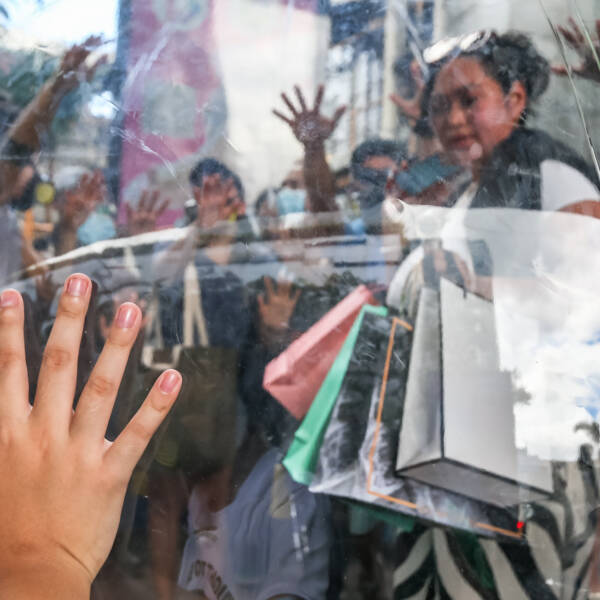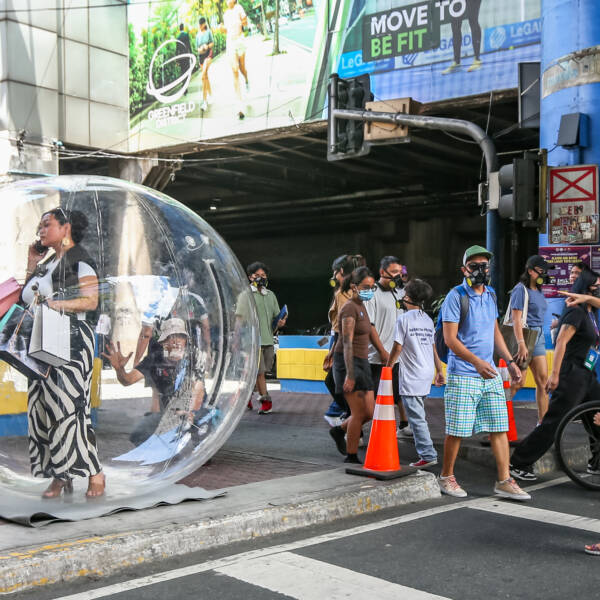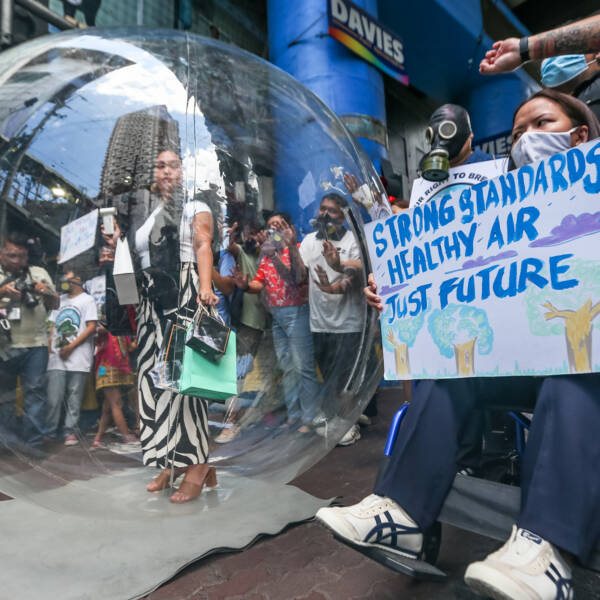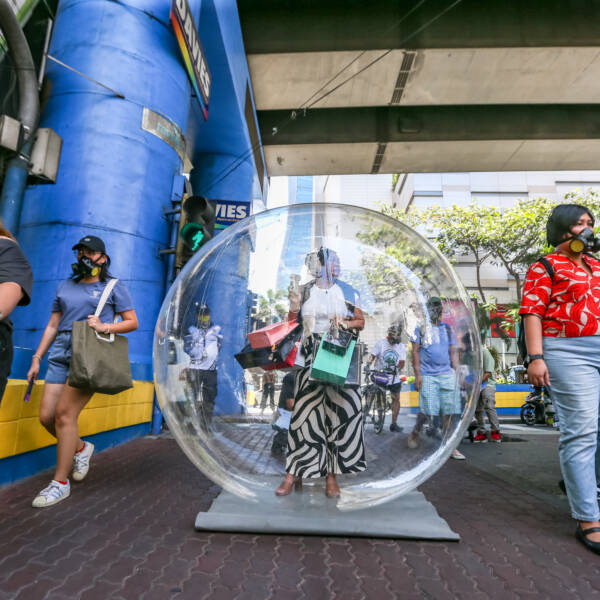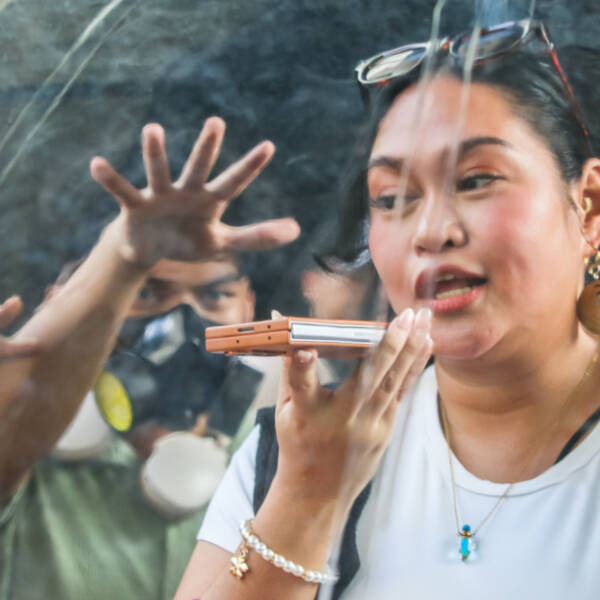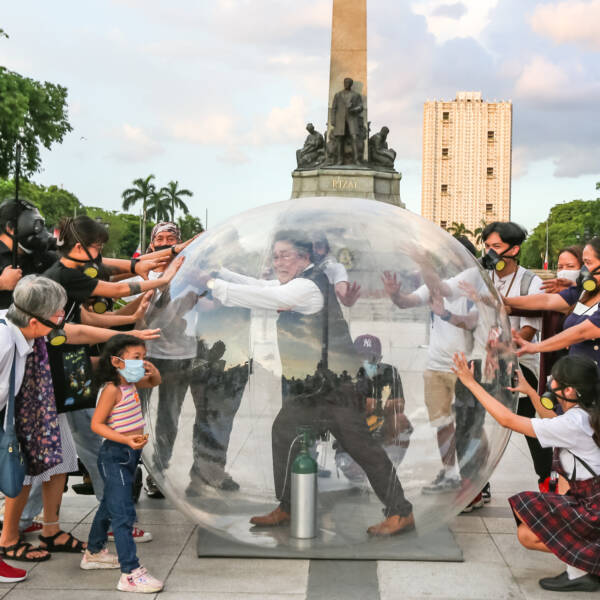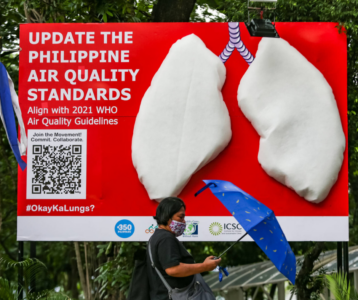Our right to breathe: Update the Air Quality Standards in the Philippines
Update the Philippine air quality standards
Air pollution, a significant health concern globally, presents an immediate challenge in the Philippines. According to the World Health Organization nearly everyone on the planet breathes air tainted with pollutants. In our context, the impact is tangible – air pollution from fossil fuels led to thousands of premature deaths in 2018 alone. Beyond its health implications, air pollution is intricately linked with climate change
Therefore to ensure cleaner air and a healthier future for us all. We call for:
- Updating our national air quality guideline values, aligning with the World Health Organization’s (WHO) latest recommendations (2021)
- Investing in and significantly enhance our air quality monitoring systems, fostering transparency and providing accessible real-time information to the public.
- Advocating for active transportation solutions, such as cycling and walking, to promote public health and reduce air pollution.
- Champion this issue in the international arena, recognizing that air pollution and climate change are global challenges that require a united, equitable approach.
The Philippine Clean Air Act of 1999 stands as a landmark legislation dedicated to the protection and enhancement of the country’s air quality. This pivotal act sets out to reduce air pollution, safeguard public health, and ensure a healthier environment for current and future generations. It serves as a model for environmental policy in the Southeast Asian region and contributes to global efforts in combating air pollution and mitigating climate change. As we commemorate the Act’s 25th anniversary, we must renew our commitment and solidify our efforts to fulfill its promises.
Each year, approximately 7 million lives globally are tragically cut short due to the adverse impacts of air pollution. This silent menace adversely affects neurological development in children, leading to premature deaths, as well as a higher prevalence of diseases such as stroke, heart disease, lung cancer, and respiratory infections, including pneumonia and allergic diseases such as asthma, allergic rhinitis, eczema and urticaria.
We recognize that particulate matter with diameters ranging 10 micrometers (PM10) and less than 2.5 micrometers (PM2.5), including substances like sulfate and black carbon, penetrate deep into the lungs and cardiovascular system, compounding the health risks for our population. Within the Philippine context, our concern is exacerbated by disconcerting statistics. A recent study has revealed that our country bears the brunt of this crisis, with air pollution responsible for 66,230 deaths in the country in 2019, of which 64,920 deaths were estimated to be adults and 1,310 children.
As health professionals and staunch advocates for both environmental and public health, we bear a profound responsibility to safeguard our communities against the perils posed by air pollution. Our role is multifaceted and compelling. We, as health professionals, can leverage our expertise and influence to advocate for stricter air quality standards, educate the public on the health risks of air pollution, and collaborate with policymakers to implement effective solutions.
And we stand ready to support the Department of Environment and Natural Resources (DENR), as the overall of the lead agency implementer of the Clean Air Act, along with the Department of Health (DOH), and other pertinent government bodies and non-government organizations, in their initiatives aimed at combating air pollution.
To protect public health, we commit to working together to:
- Update our national air quality guideline values, aligning with the World Health Organization’s (WHO) latest recommendations (2021), understanding that it will require a phased approach to achieve these stricter, health-protective levels. We are committed to support and collaborate with the DENR and DOH in providing evidence-based recommendations that will guide our approach in this process.
- Invest in and significantly enhance our air quality monitoring systems, fostering transparency and providing accessible real-time information to the public. By doing this, we can ensure stricter implementation of air quality monitoring policies and standards. As health professionals, we will actively engage with communities to translate this data into actionable steps to protect their health.
- Advocate for active transportation solutions, such as cycling and walking, to promote public health and reduce air pollution. Active transport not only improves air quality but also offers significant health benefits, including reduced rates of chronic diseases and enhanced overall well-being. We will work to create safer, more accessible infrastructure for active transportation in our communities.
- Champion this issue in the international arena, recognizing that air pollution and climate change are global challenges that require a united, equitable approach. We commit to advocating for stronger international policies and cooperation, emphasizing the need for equity and support for vulnerable communities disproportionately affected by these issues.
If the Philippines updates its air quality standards, it would mark a clear step toward moving away from our reliance on fossil fuels. With 80% of emissions coming from the transportation sector, this also now challenges lawmakers and agencies to raise the bar—setting stronger guidelines and promoting alternatives that put people first in transport and health. It’s all about making sure our children, grandchildren, and future generations for a future that is breathable, and away from fossil fuels.
Watch the highlights of the first “Life in a Bubble” action held at the Rizal Monument last April 25, 2025, featuring the award-winning actor, Soliman Cruz.
Life in a Bubble: An urgent call for clean air
Bubbles are often seen as playful, light, and harmless—but beneath their iridescent surface is a powerful metaphor. A bubble creates a temporary space, a fragile barrier that separates its occupant from the world outside.
In the context of air pollution, the bubble symbolizes a superficial refuge—a glimpse into the extreme measures privileged individuals might need to take just to breathe safely. But beyond that, there lies a deep socio-economic divide between those who can afford cleaner environments and those who cannot
As the second part of the “Life in a Bubble” creative action was taking place, the Quezon City Disaster Risk Reduction and Management Office (QCDRRMO) issued an advisory urging the public to wear masks due to deteriorating air quality in the city, citing “unhealthy to very unhealthy” air quality levels in several areas. Updating the air quality standards means implementing measures to ensure a safer, cleaner air and not compromising our health.
Watch the highlights of the recent clean air campaign, “Life in a Bubble,” held at the EDSA-Mandaluyong Pedestrian Crossing on April 28, 2025.
Renowned Filipina Actress, Mercedes Cabral Call for updated PH Air Quality Standards
Climate advocates from 350 Pilipinas held their second creative protest action for Life in a Bubble, featuring Mercedes Cabral, internationally acclaimed Filipino actress known for her standout roles in Cannes-selected films. Her performance highlighted the urgency of air pollution, underscoring the stark reality that the majority of Filipinos remain vulnerable under outdated Philippine air quality standards. Through performance art, she portrayed a wealthy shopper staged in a high-traffic public space.

Climate advocates from 350 Pilipinas joined by celebrated Filipino actress Mercedes Cabral. In the centerpiece of the creative action, Mercedes Cabral stepped into an 8-foot transparent bubble along EDSA corner Shaw Blvd. Mandaluyong City, symbolizing the privileged few able to shield themselves from toxic air, while others stood outside, exposed and forgotten. The “life in a bubble” performance laid bare the socio-economic divide in air pollution’s impact and called on the DENR to take decisive action: update national air quality standards, fully implement the Clean Air Act, and restore real-time air monitoring capacity. Photo: Leo M. Sabangan
The activity was joined by 350 Pilipinas, Ms. Mercedes Cabral,
Health Care Without Harm Southeast Asia, 350 Pilipinas Bike Squad, Polytechnic University of the Philippines Students, With the support from Clean Mobility Collective
Soliman Cruz Joins Creative Call for Clean Air in the Philippines
Acclaimed Filipino actor Soliman Cruz, honored as Best Actor at the 2022 Hanoi International Film Festival, joined climate advocates this week in a powerful performance protest urging the Department of Environment and Natural Resources (DENR) to update the country’s outdated air quality standards. Staged in Manila’s high-traffic public spaces, the creative action dramatized the stark realities of air pollution in the Philippines—particularly in Metro Manila, where vehicle emissions and industrial activity continue to choke the air.

Climate advocates from 350 Pilipinas joined by celebrated Filipino actor Soliman Cruz—honored as Best Actor at the 2022 Hanoi International Film Festival. In the centerpiece of the creative action, Soliman Cruz stepped into an 8-foot transparent bubble at Rizal Park in Manila, symbolizing the privileged few able to shield themselves from toxic air, while others stood outside, exposed and forgotten. The “life in a bubble” performance laid bare the socio-economic divide in air pollution’s impact and called on the DENR to take decisive action: update national air quality standards, fully implement the Clean Air Act, and restore real-time air monitoring capacity. PHOTO: LEO M. SABANGAN II
Breathing Billboard Lung Installation: Visualizing Air Pollution in Metro Manila
This August, the Institute for Climate and Sustainable Cities (ICSC), on behalf of the Mobility Awards co-convenors (The Climate Reality Project, Pinay Bike Commuter Community, MNL Moves), 350 Pilipinas, Health Care Without Harm, and in collaboration with different groups pushing for Clean Air, are launching the breathing billboard lung installation at the Lung Center of the Philippines (LCP)
A Lung Billboard, depicting human lungs fitted with Hepa filters and a fan that mimics breathing. This installation will illustrate the impact of air pollution on human health and serve as a powerful call to action. The billboard will be on display for 10 days in the LCP as part of a series of activities commemorating the 25th anniversary of the Clean Air Act Philippines, celebrated on June 23, 2024.
Images below shows the Breathing billboard’s condition after being installed on August 2, 2024 and on its last day on August 19, 2024.
To compare the impacts of air quality, a breathing billboard, inspired by the India-based Jhatkaa.org was deployed outside the Lung Center of the Philippines in 2024. A side-by-side comparison is from its launch (August 2, 2024) and August 21, the last day of the breathing billboard showed a drastic change as it was exposed to polluted air, rain, and other environmental conditions.
The billboard visually depicts the air pollution as collected by the attached High-Efficiency Particulate Air (HEPA) Filters. As 350 Pilipinas dismantled the installation located at the Lung Center of the Philippines, on its last day. It clearly shows how exposure to air pollution can harm our communities and drastically impact our health.
A Statement of Commitment and Collaboration for
Clean Air and a Healthier Future in the Philippines
The Philippine Clean Air Act of 1999 stands as a landmark legislation dedicated to the protection and enhancement of the country’s air quality. This pivotal act sets out to reduce air pollution, safeguard public health, and ensure a healthier environment for current and future generations. It serves as a model for environmental policy in the Southeast Asian region and contributes to global efforts in combating air pollution and mitigating climate change. As we commemorate the Act’s 25th anniversary, we must renew our commitment and solidify our efforts to fulfill its promises.
Each year, approximately 7 million lives globally are tragically cut short due to the adverse impacts of air pollution. This silent menace adversely affects neurological development in children, leading to premature deaths, as well as a higher prevalence of diseases such as stroke, heart disease, lung cancer, and respiratory infections, including pneumonia and allergic diseases such as asthma, allergic rhinitis, eczema and urticaria.
We recognize that particulate matter with diameters ranging 10 micrometers (PM10) and less than 2.5 micrometers (PM2.5), including substances like sulfate and black carbon, penetrate deep into the lungs and cardiovascular system, compounding the health risks for our population. Within the Philippine context, our concern is exacerbated by disconcerting statistics. A recent study has revealed that our country bears the brunt of this crisis, with air pollution responsible for 66,230 deaths in the country in 2019, of which 64,920 deaths were estimated to be adults and 1,310 children.
As health professionals and staunch advocates for both environmental and public health, we bear a profound responsibility to safeguard our communities against the perils posed by air pollution. Our role is multifaceted and compelling. We, as health professionals, can leverage our expertise and influence to advocate for stricter air quality standards, educate the public on the health risks of air pollution, and collaborate with policymakers to implement effective solutions.
And we stand ready to support the Department of Environment and Natural Resources (DENR), as the overall of the lead agency implementer of the Clean Air Act, along with the Department of Health (DOH), and other pertinent government bodies and non-government organizations, in their initiatives aimed at combating air pollution.
To protect public health, we commit to working together to:
- Update our national air quality guideline values, aligning with the World Health Organization’s (WHO) latest recommendations (2021), understanding that it will require a phased approach to achieve these stricter, health-protective levels. We are committed to support and collaborate with the DENR and DOH in providing evidence-based recommendations that will guide our approach in this process.
- Invest in and significantly enhance our air quality monitoring systems, fostering transparency and providing accessible real-time information to the public. By doing this, we can ensure stricter implementation of air quality monitoring policies and standards. As health professionals, we will actively engage with communities to translate this data into actionable steps to protect their health.
- Advocate for active transportation solutions, such as cycling and walking, to promote public health and reduce air pollution. Active transport not only improves air quality but also offers significant health benefits, including reduced rates of chronic diseases and enhanced overall well-being. We will work to create safer, more accessible infrastructure for active transportation in our communities.
- Champion this issue in the international arena, recognizing that air pollution and climate change are global challenges that require a united, equitable approach. We commit to advocating for stronger international policies and cooperation, emphasizing the need for equity and support for vulnerable communities disproportionately affected by these issues.
On this 25th day of June 2024, we join hands in a resolute pledge to combat air pollution and its dire consequences on our nation’s health. It is time to elevate our commitment beyond words and catalyze transformative action. Together, we can breathe life into a future where clean air is not a luxury but a fundamental right for all Filipinos.
Signed this 25th day of June 2024 at the Department of Health, Manila City, and the Department of Environment and Natural Resources – Environmental Management Bureau, Quezon City, Philippines.
List of Signatories (as of 09 July 2024):
- Department of Health
- Department of Environment and Natural Resources
- Health Care Without Harm Southeast Asia
- 350 Pilipinas
- Institute for Climate and Sustainable Cities
- Philippine College of Chest Physicians (PCCP)
- Philippine College of Physicians (PCP)
- Philippine Society of Allergy, Asthma and Immunology (PSAAI)
- Lung Center of the Philippines (LCP)
- Philippine Medical Association (PMA)
- Philippine Ambulatory Pediatric Association, Inc. (PAPA)
- Philippine College of Emergency Medicine (PCEM)
- Asia Pacific Center for Evidence Based Healthcare (APCEBH)
- ANG NARS
- Philippine Neurological Association
- Philippine Society for Reproductive Medicine (PSRM)
- Philippine Physical Therapy Association, Inc. (PPTA)
- Philippine Pharmacists Association, Inc. (PPhA)
- Philippine Society for Cervical Pathology and Colposcopy (PSCPC)
- Pediatric Nephrology Society of the Philippines (PNSP)
- Society of Gynecologic Oncologists of the Philippines (SGOP)
- Philippine Academy of Pediatric Pulmonologists (PAPP)
- Philippine Society for Pediatric Gastroenterology, Hepatology and Nutrition (PSPGHAN)
- Philippine Rheumatology Association
- Society of Pediatric Critical Care Medicine Philippines
- Pediatric Infectious Disease Society of the Philippines (PIDSP)
- Philippine Association of Medical Journal Editors (PAMJE)
- Philippine Society of General Internal Medicine (PSGIM)
- Philippine Society of Pediatric Hematology (PSPH)
- Philippine Society of Experimental and Clinical Pharmacology (PSECP)
- Philippine Pediatric Society (PPS)
- Philippine Addiction Specialists Society (PASS)
- Philippine Association of Nutrition (PAN)
- Philippine Society of Hospice and Palliative Medicine (PSHPM)
- Philippine Society for Urogynecology and Reconstructive Pelvic Surgery
- Philippine Society of Clinical and Occupational Toxicology
- Philippine Dermatological Society (PDS)
- Philippine Psychiatric Association (PPA)
- Philippine Society of Newborn Medicine (PSNbM)
- Healthcare Professionals for Christ
- Community Pediatrics Society of the Philippines (CPSP)
- Philippine League against Epilepsy (PLAE)
- Philippine League of Government and Private Midwives, Inc.
- Philippine Society of Climacteric Medicine (PSCM)
- Action on Smoking and Health Philippines
- Philippine Academy of Occupational Therapists
- Philippine Society of Hypertension
- Philippine Society for Developmental and Behavioral Pediatrics
- Philippine Academy of Family Physicians (PAFP)
- Philippine College of Occupational Medicine
- Philippine Society of Medical Oncology
- Philippine Society for Microbiology and Infectious Diseases (PSMID)
- Pain Society of the Philippines (PSP)
- Philippine College of Geriatric Medicine
- Philippine Society Of Nephrology (PSN)
- Child Neurology Society Philippines
- Philippine Society of Public Health Physicians (PSPHP)
- Philippine General Hospital Physicians’ Association
- Program for Health Systems Development, Center for Integrative and Development Studies
On June 25, 2024, we joined with over 100 healthcare professionals, CSOs, mobility advocates, and climate advocates from the country’s health sector gathered for the “Ride For Their Lives bike ride to advance initiatives prioritizing planetary health amid the 25th anniversary of the Clean Air Act Philippines
#OkayKaLungs Visual Study
Central to the campaign is the mobilization of health professionals to endorse the “Statement of Commitment and Collaboration for Clean Air and a Healthier Future in the Philippines,” which underscores the health sector’s dedication to combating air pollution. The DOH, DENR, together with over 40 medical societies in the Philippines, have officially demonstrated their commitment by signing the statement. At its core, the collaborative statement calls for the alignment of our air quality guidelines with WHO recommendations, enhancement of air quality monitoring systems, promotion of active transportation solutions, and advocating for stronger international policies to address air pollution and climate change.
Southeast Asian countries are highly vulnerable to climate-related hazards such as droughts, cyclones, sea level rise, floods and landslides, according to a published report1 by the International Development Research Center (IDRC). In addition, six (6) countries from Asia namely Myanmar, Philippines, Bangladesh, Pakistan, Vietnam and Thailand are among the most vulnerable nations in the world according to the Top 10 Global Climate Risk Index.


